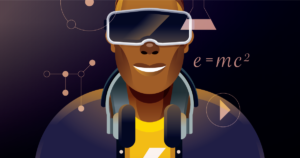Re-Imagining Schools
Over 9 in 10 educators are interested in the benefits of tech
The Classrooms Of The Future
What Do Educators Think?
98% think that interactive video* is going to be important to education in the future
98% anticipate self-paced curriculums
98% believe video will play an important role in the personalization of education
89% are interested in VR/AR/360 video
The Benefits Of Tech
Greater Reach: 1 in 3 education professionals see video as a way to reach students who don’t have access to classroom learning
Lifelong Learning: More than ever students will need the ability to continue learning new skills throughout their lives
AI Revolution: From 1995 to 2014, use of IT more than doubled in OECD countries, and it’s still growing – students need digital skills to succeed
Diverse Careers: 1 in 3 15 year-olds plan to pursue one of the top 10 most popular occupations, regardless of whether they’ll continue to be in demand
Technology provides a way to show students a wider range of opportunities
86% of educators think students need video capture skills to succeed in their future workplace
Using Video To Maximize Classroom Time
Educational institutions say video increases:
- Student satisfaction: 91%
- Student achievements: 82%
- Educator collaboration: 80%
- Professional development: 80%
From 2014 to 2019, educators increased use of video for:
- Student assignments
- Capturing campus events
- Flipped instruction
- Personal introductions in online learning
- Feedback on assignments
- Flipped Instruction
What Is It?
Traditional Teaching
In class: Teachers review homework and present new content
Out of class: Students do homework to practice new learning
Instruction is 35% student-centered, 65% teacher-centered
Flipped Focus
Out of class: Students learn new content through video & tech
In class: Students discuss and explore applications
Instruction is 80% student-centered, 20% teacher-centered
Benefits Of Flipping
Increases student engagement, which in turn improves learning outcomes
Learning is more collaborative, helping students build soft skills
Teachers lead students to investigate ideas and guide self-discovery
Potential Drawbacks
Classrooms are may become more active, noisy, and distracting
Students may have trouble focusing in a flipped learning environment
Flipped instruction must be executed well to reap the benefits
Left Behind:
- In the U.S., nearly 18% of school-age children don’t have internet access at home — meaning they can’t do homework, especially if it relies on tech
- Public libraries, schools, and corporate donors are working to provide wireless hotspots to students in need
- Installing WiFi on school buses lets rural students take advantage of longer commutes
Chatbots For Education
How Chatbots Improve Learning
- Spaced Interval Learning: By reviewing material repeatedly over time, student are better able to remember what they’ve learned
- Software algorithms can predict when you’ll start to forget what you’ve learned and time reminders to optimize memorization
- Immediate Feedback: Learners who receive feedback immediately show greater improvement than those who get delayed feedback
- Teachers can’t always grade an essay, but an AI can — AI can even score papers within 92% accuracy, compared to human graders
- Self-Paced Learning: Chatbots can track student performance and adjust the curriculum to better meet their individual needs
- Chatbots serve as a guide to help pace learning, not a replacement for a teacher or professor
Snatchbot
- Free chatbot that can be embedded in learning platforms like Blackboard
- Can be programmed with answers to FAQs relating to course syllabus
- Provides answers with links and images to help guide students through the course
- Gives students immediate answers and relieves teachers’ email load
Summit Learning Project
- Chatbots adapt learning to each student, enabling self-paced learning
- Acts as a virtual tutor that notes students’ trouble spots and adjusts to their needs
- Teachers can focus on creating lessons, while chatbots take over pacing and assessment as students move from one lesson to the next
Jill Watson
- Chatbot built on IBM’s Watson and trained using data from the course’s forum
- Created by Asok Goel at Georgia Tech, and added to an online course as a teaching assistant — Students had no idea Jill was really an AI
- Jill answers routine, technical questions — Like “Where do I find ___?”
Communicating With Parents
- Tools like Facebook Messenger & Remind help teacher and staff communicate with parents and older students outside of the classroom
- BUT, the can also provide answers when aren’t available to chat
- Preprogrammed answers to routine inquiries
- Auto replies to messages outside of office hours
The future of education, personalized through tech
Sources:
https://corp.kaltura.com/wp-content/uploads/2019/07/The_State_of_Video_in_Education_2019-1.pdf
https://www.disability.illinois.edu/sites/default/files/Spaced%20Interval%20Learning%20Technique.pdf
http://www.oecd.org/education/Envisioning-the-future-of-education-and-jobs.pdf
https://files.eric.ed.gov/fulltext/EJ1151444.pdf
https://www.pewresearch.org/fact-tank/2015/04/20/the-numbers-behind-the-broadband-homework-gap/
https://www.usnews.com/high-schools/blogs/high-school-notes/articles/2017-10-02/how-to-help-high-schoolers-without-home-internet-access
https://blog.interactiveschools.com/blog/chatbots-can-they-work-for-your-school
http://www.iacis.org/iis/2018/4_iis_2018_44-52.pdf?fbclid=IwAR2XfBGFzj0ZyOzf7HEpyhLSKqiw3EsCHnhmROCsBFsJ_fKevMl35-tBXgk
https://blog.digistorm.com.au/how-messenger-bots-are-being-used-in-education
https://elearningindustry.com/chatbots-in-education-applications-chatbot-technologiessnatchbot.me/education
https://venturebeat.com/2018/05/28/chinese-schools-are-testing-ai-that-grades-papers-almost-as-well-as-teachers/
https://blog.interactiveschools.com/blog/chatbots-can-they-work-for-your-school
https://www.edutopia.org/blog/tips-providing-students-meaningful-feedback-marianne-stenger


